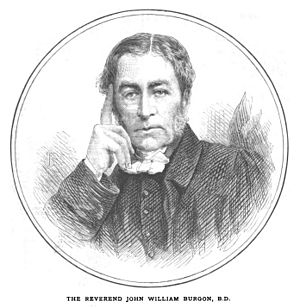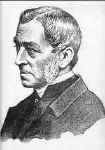John Burgon facts for kids
John William Burgon (born August 21, 1813 – died August 4, 1888) was an English church leader. He became the Dean of Chichester Cathedral in 1876. During his life, he was known for his poems and for defending the Book of Genesis as a true historical account. After his death, people mainly remembered him for protecting the traditional text of the New Testament part of the Bible.
Contents
Who Was John Burgon?
John Burgon was born in Smyrna (now İzmir, Turkey) on August 21, 1813. His father, Thomas Burgon, was an English merchant and also an expert in old coins. Later, his father worked at the British Museum. John's mother was the daughter of the Austrian consul and his English wife.
When John was very young, his family moved to London. He went to school there and later worked in his father's business for a few years. In 1841, Burgon went to Worcester College, Oxford, and finished his studies in 1845.
Burgon's Church Career
In 1846, Burgon was chosen for a special position at Oriel College, Oxford. He was greatly influenced by his brother-in-law, Henry John Rose, who was a conservative church leader. Burgon made Oxford his main home.
In 1863, he became the vicar (a type of priest) of the University Church of St Mary the Virgin. He became well-known for his strong sermons against a book called Essays and Reviews. In these sermons, he defended the Bible's truth. He believed that people should either believe all of the Bible or none of it.
In 1867, Burgon was named a professor of divinity (religious studies). He also wrote about the last twelve verses of the Gospel of Mark, saying they were real.
Defending the Bible's Text
Burgon strongly disagreed with Brooke Foss Westcott and Fenton John Anthony Hort. These two scholars were creating a new version of the Bible called the Revised Version. Burgon believed they were relying too much on one old manuscript, the Vatican Codex (B). He thought this manuscript was "not trustworthy." He wrote articles and books, like "The Revision Revised," to share his strong opinions.
In 1876, Burgon became the Dean of Chichester Cathedral. He continued to speak out on church matters. He also influenced Rev. Charles Henry Waller at Oxford.
John Burgon never married. He died in Chichester on August 4, 1888. He was buried in Holywell Cemetery in Oxford. There is a plaque in Chichester Cathedral and a window in the lady chapel that remember him.
What Were Burgon's Famous Writings?
John Burgon was known for his writing, especially his poetry.
The Poem "Petra"
In 1845, Burgon won the Newdigate Prize for his poem called Petra. This poem was about the ancient city of Petra in Jordan, even though he had never seen it. A famous part of the poem describes the city's buildings:
It seems no work of Man's creative hand,
by labour wrought as wavering fancy planned;
But from the rock as if by magic grown,
eternal, silent, beautiful, alone!
Not virgin-white like that old Doric shrine,
where erst Athena held her rites divine;
Not saintly-grey, like many a minster fane,
that crowns the hill and consecrates the plain;
But rose-red as if the blush of dawn,
that first beheld them were not yet withdrawn;
The hues of youth upon a brow of woe,
which Man deemed old two thousand years ago,
match me such marvel save in Eastern clime,
a rose-red city half as old as time.
This part of the poem is most famous for its last line: "a rose-red city half as old as time." This line actually uses a phrase from another writer, Samuel Rogers. The full poem is 370 lines long.
A writer named Hugh Kenner once explained that when Burgon wrote "half as old as time," he was being very precise. In Burgon's time, people believed the world was created in 4004 B.C. So, in 1845, the world was about 5849 years old. Half of that time would place Petra's founding around 1080 B.C.
Other Literary Works
Burgon also wrote essays about people like Henry Longueville Mansel. These essays were collected and published in a book called Twelve Good Men (1888).
Burgon's Legacy Today
John Burgon's name is still remembered in a few ways today.
The Burgon Society
The Burgon Society was started in 2000. It focuses on studying and using academic dress, like graduation robes and hoods. This society is named after Burgon because he is the only person to have a specific hood shape named after him.
The Dean Burgon Society
Another group, the Dean Burgon Society, also carries his name. This society supports Burgon's strong belief that the Bible is the inspired Word of God. They continue to defend the traditional text of the Bible, similar to Burgon's views against the Revised Version.
In Popular Culture
The phrase "match me such marvel" from Burgon's poem Petra is used as the title of a fictional novel. This novel appears in Anthony Powell's twelve-volume book series, A Dance to the Music of Time.
Burgon's Theological Books
- The Book of Common Prayer: With Illustrations Chiefly from the Old Masters, with Henry John Rose.
- A Plain Commentary on the Four Holy Gospels (in volumes)
- Inspiration and Interpretation: Seven Sermons Preached before the University of Oxford (1861)
- The Last Twelve Verses of Mark (1871)
- The Servants of Scripture (1878)
- The Revision Revised (1881)
- Letters to Dr. Scrivener : Sacred Greek codices at home and abroad (1882)
- The First Chapter of Genesis: A Reply and a Postscript (1886)
Books Published After His Death
- Causes of Corruption of the Traditional Text of the Holy Gospels (1896)
- The Traditional Text of the Holy Gospels vindicated and established (1896)
- Edward Miller, A Textual Commentary Upon the Holy Gospels, Part I, Matthew i-xiv: Largely From the use of Materials, and Mainly on the Text, Left by the Late John William Burgon (1899)



